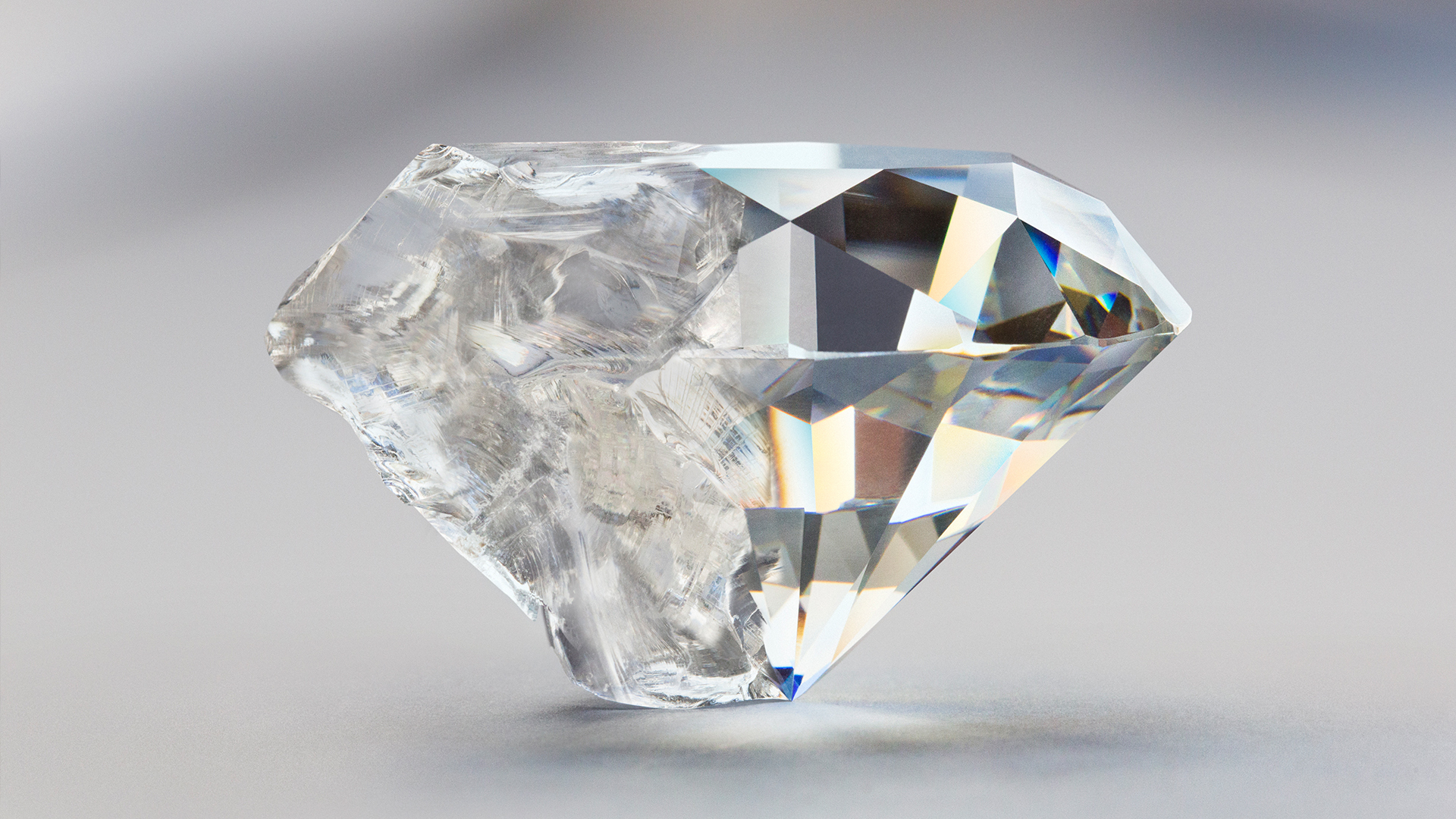
Marilyn Monroe:
“Diamonds are a girl’s best friend.”
Simone Del Rosario:
We’ve heard this for years, but the diamond industry is facing a generational reckoning.
Do young people still value natural diamonds pulled from the ground or do they prefer a bargain with lab-grown diamonds?
jacquiefenton:
“Lab-grown diamonds don’t count. They’re cheap. Get a real diamond.”
gabriellerozmarniewicz:
“What types of people I legitimately think are so weird. People that are like, I will only accept a natural diamond engagement ring.”
“Really really big scam going on right now online. It’s the word lab-grown.”
Simone Del Rosario:
Lab-grown diamonds have the same chemical and physical properties as their natural counterpart.
In fact, the Federal Trade Commission ruled a diamond is a diamond, whether it’s man made or mined.
Martin Rapaport:
“These guys go, ‘They’re exactly the same.’ You’re not allowed to call them real diamonds, according to the FTC, but they still call them real diamonds.”
Simone Del Rosario:
Martin Rapaport is a huge name in the diamond industry.
Martin Rapaport:
“We are today the primary source of diamond price and market information for the diamond industry.”
“We’re also running the largest diamond trading network in the world with listings of about $9 billion of diamonds offered for sale every day.”
Matthew McConaughey:
“Guys, did you know that diamonds are about as common as taxis on 5th avenue? The value is entirely sentimental. Maintained by supply, demand, and advertising.”
Simone Del Rosario:
It wasn’t until De Beers launched its now classic slogan in 1947 that diamonds grew to be a worldwide symbol of engagement.
Advertisement:
“How else could two months’ salary last forever? A diamond is forever. De Beers.”
Aja Raden:
It just seeped into the popular consciousness in a way that didn’t seem deliberate, but was.
Simone Del Rosario:
Aja Raden is a jewelry expert and author of the New York Times bestseller, “Stoned: Jewelry, Obsession and how desire shapes the world.”
Aja Raden:
When World War Two was over, all of the money in the western world had been reshuffled
There was this new thing that had never existed before in the world called the middle class.
So they had to figure out how to sell diamonds, not to a small number of obscenely wealthy people, but to an enormous number of comfortable people. And what they did was they came up with the diamond engagement ring.
Simone Del Rosario:
The campaign, which conti nued for decades, showed movie stars dripping in diamonds. And it quickly paid off. Within three years, diamond sales jumped by 50 percent.
Martin Rapaport:
“De beers, what they did was, they were able to attach the diamond to that fundamental need and to give gifts. It’s not just the woman who’s receiving the gift, you know, the woman is very happy when she receives the diamond. But it’s not only because she got a diamond, she got a man.”
Simone Del Rosario:
Nearly 80 years later, the luster is wearing off with younger generations. The average cost of a natural diamond engagement ring is more than $5,000. And the majority of unmarried millennials and Gen Zers aren’t worried about keeping up with what some call outdated traditions.
Money is a big reason many are bucking marriage – for now. For those who do see themselves tying the knot someday, lab-grown diamonds might catch their eye, costing between 80 to 95 percent less than natural stones.
In 1954, General Electric scientists created a machine that squeezed carbon under 1.5 million pounds of pressure per square inch at 5000 degrees Fahrenheit. The machine made the hardest substance on earth, diamonds.
They weren’t looking to sparkle, they were looking to slice. The synthetic diamonds became tools for cutting metal and glass.
But as the diamond-pressing process refined, the product eventually reached the clarity of natural diamonds used by jewelers.
Martin Rapaport:
Guy walks into a store,he says, I gotta buy a nice diamond for my wife. How much do you want to spend? The jeweler slyly asks, and they’ll say, oh, I can spend $5,000. He says, okay, he shows him a diamond,it costs $20,000. And then he says but you know what? I can give you a four carat diamond for that price. Same thing. Same exact shiny, shiny. Oh, You want to buy a two carat VS2 diamond? Why should you spend $20,000, I can give you something for $10,000. But it only cost him $2,000. Maybe $4,000. So the margin, the profit margin blows your brain. It’s unbelievable.
Simone Del Rosario:
Sixty three percent of independent jewelers have gotten in on the lab-grown action. Then big names like De Beers entered the race.
Aja Raden:
If you can’t beat them, join them. But still try to beat them while you’re joining them.
Simone Del Rosario:
In 2018 De Beers launched its lightbox brand of synthetic diamonds, with one carat stones retailing for $800.
Aja Raden:
So DeBeers insisted forever. For years, they would never they would never have anything to do with these filthy scuzzy fake diamonds.
They didn’t just switch horses and go, well I guess now we sell lab grown diamonds. The future is here. Taste the rainbow. Instead,
they’re making the worst jewelry they can possibly make out of these frankly, exquisite lab grown diamonds. And they’re marketing it as badly as they can figure out how to market it. They’re making sure it seeps into your consciousness just like it did with diamonds. The message they want you to have is lab-grown diamonds are not real. They’re charming. You should definitely buy some, but they’re cheap and they’re fake. And it’s working.
Simone Del Rosario:
The natural diamond market was estimated at $71 billion last year, while lab-grown diamond sales are around $16 billion, industry analyst Paul Ziminisky told SAN.
Prices for wholesale polished diamonds plunged 20 percent last year. But there’s more to the market drop than this synthetic substitute.
Martin Rapaport:
“COVID came in and really shook everybody up.”
“Remember, there was no vacation really taking place at that time, no travel, people were stuck at home. And so diamond purchases and jewelry purchases were very big winners, when you had those government funds coming through. But then it stopped. The party was over.”
Simone Del Rosario:
And as the music stopped, synthetics surged. Sales of lab-grown diamonds jumped 38 percent from 2021 to 2022.
Beyond the bargain price, sustainability is pushing some people toward lab-grown gems. Ethical conflicts have marred the diamond mining industry; in the 1990s the diamond trade was at the center of African civil wars.
While the situation is far less volatile today, human rights activists still warn that some in the diamond industry are not maintaining international labor standards. Meanwhile the diamond industry touts economic advantages and infrastructure brought to mining communities.
lo_wens:
“Which would you go with, the lab-grown or the natural diamond?”
Simone Del Rosario:
A big debate in social media jewelry circles is about the resale value of lab-grown diamonds.
{SOCIAL MEDIA – No Resale}
detroitdiamondgirl:
“No to lab-grown diamonds, just no. They’re a bad investment, horrible resale.”
elissarcouture:
“You have a lab-grown diamond, you try to sell that. It’s basically worth nothing.”
Simone Del Rosario:
When you can reproduce it with a machine, how much value does it hold?
But those in favor of saving a few bucks have questions of their own.
lina.hara:
“Who do you foresee yourself selling your engagement ring to?”
Simone Del Rosario:
And for that matter, will natural diamonds hold their value?
Aja Raden:
We all believe diamonds are the most valuable gemstones in the world and the rarest and the most special, but the truth is, they are the least rare and the least special, most of them.
Simone Del Rosario:
No matter the changing generational trends, Rapaport believes there will always be a market for luxury.
Martin Rapaport:
“Diamonds are forever, little old ladies are not. So you’re gonna get to a situation here, where there’s going to be huge wealth moving for these baby boomers to these worthy or unworthy millennials.”
“Diamonds aren’t for everybody. Diamonds are for people that have money, forgive me, I like to sell diamonds to rich people.
Marilyn Monroe:
“Diamonds (diamonds) are a girl’s best…best friend.”







